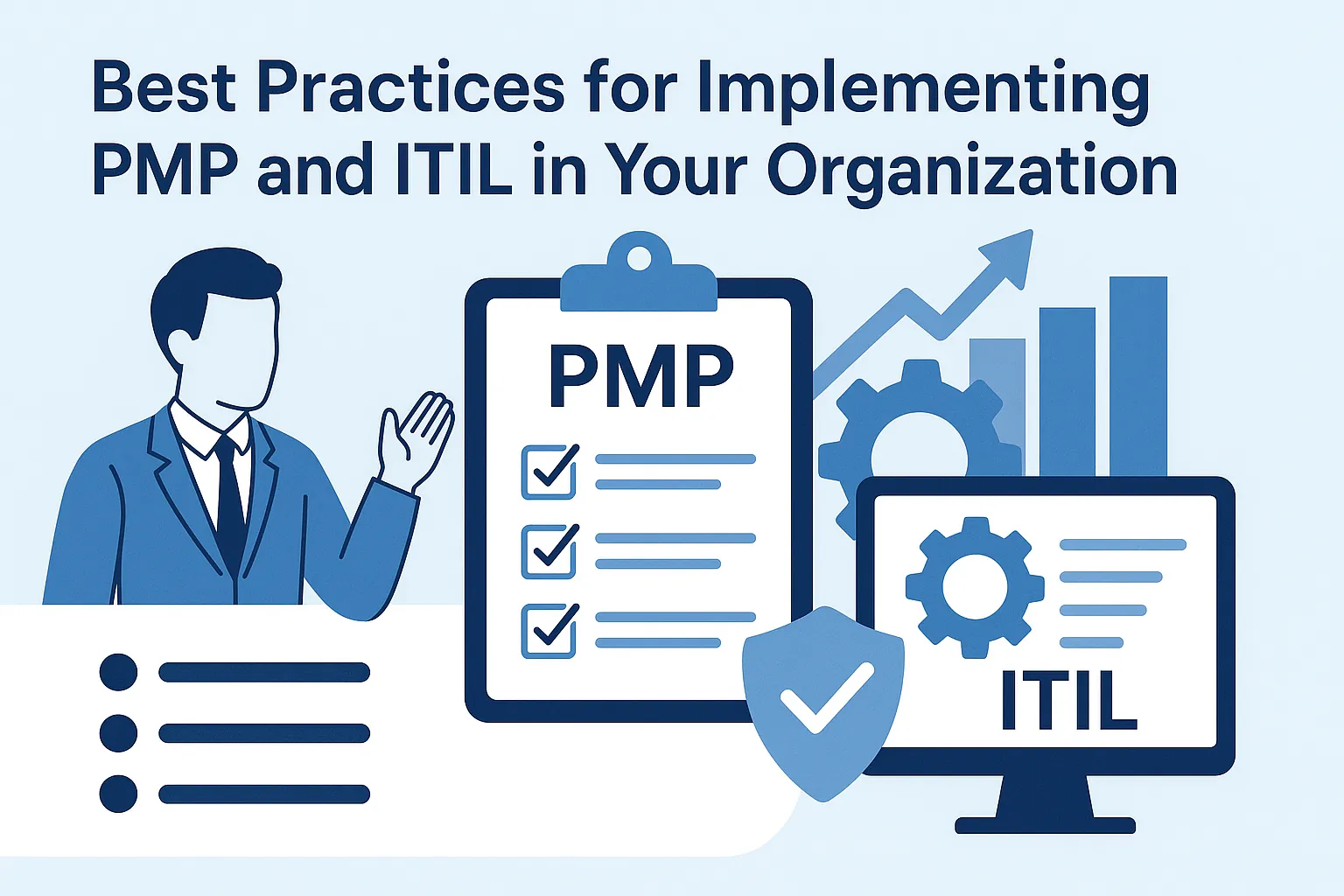Introduction
Organizations are increasingly recognizing the importance of structured methodologies to enhance their project management capabilities. Two prominent frameworks that have gained significant traction are Project Management Professional (PMP) and Information Technology Infrastructure Library (ITIL). Understanding these methodologies and their core principles is essential for leaders and project management teams aiming to optimize their operations and service delivery.
- Defining PMP: The Project Management Professional (PMP) certification is a globally recognized credential that signifies a project manager’s expertise in leading and directing projects. Core principles of PMP include the five process groups: Initiating, Planning, Executing, Monitoring and Controlling, and Closing. These principles provide a structured approach to managing projects, ensuring that they are completed on time, within scope, and on budget.
- Defining ITIL: The Information Technology Infrastructure Library (ITIL) is a set of best practices designed to align IT services with the needs of the business. ITIL’s core principles focus on service management, emphasizing the importance of delivering value to customers through effective service delivery and continuous improvement. Key components include service strategy, service design, service transition, service operation, and continual service improvement.
- Relevance in Modern Organizations: Both PMP and ITIL are highly relevant in contemporary organizations as they provide frameworks that enhance efficiency and effectiveness. PMP equips project managers with the tools to manage projects systematically, while ITIL ensures that IT services are delivered in a way that meets business objectives. The integration of these methodologies can lead to improved project outcomes and enhanced service delivery, making them indispensable in today’s competitive landscape.
Understanding PMP and ITIL
Two prominent methodologies stand out: Project Management Professional (PMP) and Information Technology Infrastructure Library (ITIL). Both frameworks offer structured approaches to managing projects and IT services, but they serve different purposes and audiences. Here’s a foundational understanding of each methodology, their phases, and key differences.
The PMP Framework
The PMP framework is designed to guide project managers through the lifecycle of a project. It encompasses five key phases:
- Initiation: This phase involves defining the project at a high level, identifying stakeholders, and obtaining authorization to proceed. It sets the groundwork for what the project aims to achieve.
- Planning: During this phase, detailed planning occurs, including defining project objectives, scope, timelines, resources, and risk management strategies. This is crucial for ensuring that all aspects of the project are considered and aligned with organizational goals.
- Execution: This phase focuses on implementing the project plan by coordinating people and resources, managing stakeholder expectations, and ensuring that project deliverables are produced as planned.
- Monitoring and Controlling: Throughout the project, this phase involves tracking progress, measuring performance against the project plan, and making necessary adjustments to stay on track. It ensures that the project remains aligned with its objectives.
- Closure: The final phase involves formally closing the project, which includes finalizing all activities, obtaining stakeholder acceptance, and documenting lessons learned for future projects.
The PMP framework emphasizes clear project objectives, timelines, and resource management, making it suitable for a wide range of projects across various industries [2][3].
The ITIL Framework
ITIL, on the other hand, is a framework focused on IT service management (ITSM) and is structured around a service lifecycle that includes the following stages:
- Service Strategy: This stage involves defining the service offerings and ensuring they align with business objectives. It focuses on understanding customer needs and market conditions.
- Service Design: In this phase, the services are designed to meet the requirements identified in the strategy phase. This includes designing processes, systems, and architectures that will support the services.
- Service Transition: This stage focuses on the planning and management of service changes, ensuring that new or modified services are delivered effectively and efficiently.
- Service Operation: This phase involves the day-to-day management of services, ensuring they are delivered as intended and that any issues are resolved promptly.
- Continual Service Improvement: This ongoing phase emphasizes the need for regular assessment and improvement of services and processes to enhance efficiency and effectiveness.
ITIL is particularly customer-focused, aiming to improve service quality and customer satisfaction through best practices in IT service management [12][15].
Key Differences Between PMP and ITIL
While both PMP and ITIL provide structured methodologies, they differ significantly in scope, focus, and application:
- Scope: PMP is broader in scope, applicable to any project across various industries, while ITIL is specifically tailored for IT service management [3][4].
- Focus: PMP emphasizes project delivery and management, focusing on achieving specific project objectives within defined constraints. In contrast, ITIL focuses on the delivery and management of IT services, prioritizing customer satisfaction and service quality [2][12].
- Application: PMP is often used in project-based environments where clear objectives and timelines are critical. ITIL is applied in organizations that require a structured approach to managing IT services and aligning them with business needs [2][4].
Understanding these frameworks and their differences is essential for organizations looking to adopt both methodologies effectively. By leveraging the strengths of each, organizations can enhance their project management capabilities and improve IT service delivery.
Assessing Organizational Needs
When organizations consider implementing Project Management Professional (PMP) and Information Technology Infrastructure Library (ITIL) methodologies, it is crucial to conduct a thorough assessment of their specific needs. This evaluation will help identify gaps in current project and service management practices, ensuring that the chosen methodologies align with organizational goals. Here are some practical steps to guide this process:
- Conduct a Thorough Needs Assessment: Begin by evaluating your organization’s existing project management and IT service management practices. This involves identifying strengths and weaknesses within current processes. By assessing these areas, organizations can pinpoint specific gaps that need to be addressed to enhance overall performance and efficiency. This step is essential for understanding where improvements can be made and how PMP and ITIL can be integrated effectively [2][8].
- Engage Stakeholders: Involve key stakeholders from various departments to gather insights on the challenges they face and their expectations from project and service management practices. Engaging stakeholders ensures that the assessment reflects a comprehensive view of the organization’s needs. This collaboration can uncover valuable perspectives that may not be apparent from a top-down approach, leading to a more tailored implementation strategy [4][9].
- Determine Methodology Alignment: After gathering insights and identifying gaps, organizations should evaluate which methodology—PMP, ITIL, or a combination of both—best aligns with their strategic goals. Consider factors such as the nature of projects, the complexity of IT services, and the overall business objectives. This alignment is crucial for ensuring that the selected methodologies will effectively support the organization’s mission and enhance service delivery [3][5][10].
By following these steps, organizations can create a solid foundation for implementing PMP and ITIL methodologies, ensuring that they are well-suited to meet their unique needs and drive success in project and service management.
Creating a Unified Strategy
Integrating Project Management Professional (PMP) methodologies with Information Technology Infrastructure Library (ITIL) practices can significantly enhance an organization’s ability to deliver projects and manage IT services effectively. Here are practical steps to create a cohesive strategy that leverages both frameworks:
- Develop a Strategic Plan: Begin by crafting a strategic plan that explicitly incorporates both PMP and ITIL methodologies. This plan should outline how each framework will contribute to the organization’s overall goals. It is essential to understand the context of your organization and define desired outcomes, ensuring that both project management and service management practices are aligned with the organization’s mission and vision [3].
- Identify Key Performance Indicators (KPIs): Establish KPIs that will help monitor the effectiveness of the integrated approach. These indicators should reflect both project success and service delivery performance. For instance, you might track project completion rates, customer satisfaction scores, and service level agreement (SLA) compliance. This dual focus will provide a comprehensive view of how well the organization is performing in both areas [6].
- Ensure Alignment Between Objectives: It is crucial to ensure that the objectives of project management and service management are aligned. This can be achieved by fostering collaboration between project teams and IT service management teams. Regular communication and joint planning sessions can help identify overlapping goals and ensure that both teams are working towards common outcomes. This alignment not only enhances efficiency but also improves customer relationships and overall service quality [6][10].
- Implement Processes Gradually: When adopting both methodologies, consider a phased approach. Start with a pilot project that integrates both PMP and ITIL practices, allowing your organization to learn and adapt before a full-scale rollout. This iterative process will enable you to gather feedback and make necessary adjustments, ensuring a smoother implementation across the organization [2][10].
- Focus on Value Creation: Both PMP and ITIL emphasize the importance of delivering value. Ensure that your strategic plan prioritizes value creation for stakeholders. This can involve identifying key areas where project outcomes can enhance service delivery and vice versa. By focusing on value, you can foster a culture that appreciates the contributions of both methodologies [10].
By following these steps, organizations can create a unified strategy that effectively integrates PMP and ITIL, leading to improved project outcomes and enhanced IT service management. This cohesive approach not only streamlines processes but also positions the organization for long-term success in a competitive landscape.
Training and Development
Implementing both Project Management Professional (PMP) and Information Technology Infrastructure Library (ITIL) methodologies in an organization requires a strong emphasis on training and development. This ensures that team members are well-equipped to apply best practices effectively, leading to improved project outcomes and service delivery. Here are some practical steps organizations can take to foster a culture of continuous learning and development in this area:
Training Programs for Project Managers on PMP Practices
- Structured PMP Training Courses: Organizations should invest in structured training programs that cover the PMBOK (Project Management Body of Knowledge) guide. These courses typically range from two to five days and focus on key project management principles, tools, and techniques. Participants will learn how to manage projects effectively, which is crucial for aligning project goals with organizational objectives [3].
- Workshops and Simulations: Incorporating hands-on workshops and simulations can enhance learning by allowing project managers to practice real-world scenarios. This experiential learning approach helps in understanding the complexities of project management and prepares them for challenges they may face in their roles.
- Mentorship Programs: Establishing mentorship programs where experienced project managers guide less experienced team members can facilitate knowledge transfer and skill development. This not only builds confidence but also fosters a collaborative environment.
ITIL Certification Options for IT Teams
- ITIL Foundation Certification: This entry-level certification provides a comprehensive overview of ITIL principles and practices. It is essential for IT team members to understand the framework to align IT services with business needs effectively [4].
- Advanced ITIL Certifications: For those looking to deepen their expertise, advanced certifications such as ITIL Practitioner, ITIL Intermediate, and ITIL Expert are available. These programs focus on specific areas of IT service management and help teams implement ITIL best practices in their daily operations [11].
- Continuous Learning Opportunities: Organizations should encourage IT staff to pursue ongoing education through workshops, webinars, and conferences related to ITIL. This commitment to continuous learning ensures that teams stay updated on the latest trends and practices in IT service management.
Encouraging Cross-Training Between Project Management and IT Service Management Teams
- Integrated Training Sessions: Organizing joint training sessions for both project management and IT service management teams can foster a better understanding of each other’s roles and responsibilities. This cross-training approach helps in breaking down silos and encourages collaboration [8].
- Shared Best Practices: By sharing best practices from both PMP and ITIL methodologies, organizations can create a more cohesive strategy for managing projects and IT services. This integration can lead to improved efficiency and effectiveness in achieving organizational goals [14].
- Collaborative Projects: Encouraging teams to work together on projects can provide practical experience in applying both PMP and ITIL principles. This collaboration not only enhances skill sets but also promotes a culture of teamwork and shared accountability.
Implementing Best Practices
When organizations aim to adopt both Project Management Professional (PMP) and Information Technology Infrastructure Library (ITIL) methodologies, it is essential to implement best practices that facilitate a smooth integration. Here are some practical steps to consider:
- Establish a Pilot Project: Initiating a pilot project is a strategic way to test the integration of PMP and ITIL within your organization. This project should be carefully selected to represent a typical scenario where both methodologies can be applied. By doing so, you can evaluate the effectiveness of combining these frameworks in real-time, identify potential challenges, and gather insights that can inform broader implementation efforts. This approach allows for adjustments before a full-scale rollout, minimizing risks associated with larger projects [6][10].
- Utilize Best Practices from Both Methodologies: Leveraging the strengths of both PMP and ITIL can significantly streamline processes. PMP emphasizes clear project objectives, timelines, and resource management, which can enhance ITIL’s focus on continuous improvement and service delivery. By integrating these best practices, organizations can create a more cohesive project management environment that aligns with IT service management goals. This synergy can lead to improved efficiency and effectiveness in delivering IT services [4][14].
- Encourage Collaboration Between Teams: Fostering collaboration between project management and IT service management teams is crucial for successful implementation. This can be achieved through regular communication, joint training sessions, and shared goals that emphasize the importance of both methodologies. By creating a culture of collaboration, organizations can ensure that both teams work towards common objectives, leading to better alignment of project outcomes with IT service delivery standards. This collaborative approach not only enhances team dynamics but also promotes a unified strategy for managing projects and IT services [11][12].
By following these practical steps, organizations can effectively implement PMP and ITIL methodologies, leading to improved project outcomes and enhanced IT service management. The integration of these frameworks not only supports organizational goals but also prepares teams to adapt to the ever-evolving demands of the business landscape.
Monitoring and Continuous Improvement
The integration of both Project Management Professional (PMP) and Information Technology Infrastructure Library (ITIL) methodologies can significantly enhance an organization’s operational efficiency and service delivery. However, the successful adoption of these frameworks requires a commitment to ongoing assessment and adaptation. Here are some practical steps for organizations to ensure effective monitoring and continuous improvement of their PMP and ITIL practices:
- Set Up Regular Review Meetings: Establish a schedule for regular review meetings that involve key stakeholders from both project management and IT service management teams. These meetings should focus on assessing the performance and impact of the implemented practices. By discussing successes, challenges, and lessons learned, organizations can ensure that both methodologies are aligned with their strategic goals and are effectively contributing to project outcomes and service delivery improvements.
- Gather Feedback from Teams: Actively solicit feedback from team members who are directly involved in the execution of projects and IT services. This feedback is invaluable for identifying areas for improvement. Encourage an open dialogue where team members can share their experiences, challenges, and suggestions for enhancing processes. This collaborative approach not only fosters a culture of continuous improvement but also empowers teams to take ownership of their work and contribute to the overall success of the organization.
- Implement a Continuous Improvement Plan: Leverage insights gained from both PMP and ITIL frameworks to develop a robust continuous improvement plan. This plan should outline specific actions to address identified areas for enhancement, set measurable goals, and define key performance indicators (KPIs) to track progress. By integrating best practices from both methodologies, organizations can create a comprehensive approach to continuous improvement that enhances project outcomes and service quality. For instance, utilizing ITIL’s Continual Improvement Model alongside PMP’s focus on project performance can lead to more effective resource allocation and better alignment with business objectives.
By prioritizing monitoring and continuous improvement, organizations can ensure that their adoption of PMP and ITIL methodologies remains relevant and effective. This proactive approach not only enhances project management and IT service delivery but also positions the organization for long-term success in an ever-evolving business landscape.
Conclusion
The integration of both Project Management Professional (PMP) and Information Technology Infrastructure Library (ITIL) methodologies is crucial for organizations aiming to enhance their project and service management capabilities. Adopting these frameworks not only streamlines processes but also aligns project objectives with service delivery, ultimately leading to improved efficiency and effectiveness.
Importance of Adopting Both Methodologies:
- PMP emphasizes clear project objectives, timelines, and resource management, which can significantly amplify the focus on continuous improvement that ITIL promotes. This synergy allows organizations to manage projects more effectively while ensuring that services are aligned with business needs and customer expectations [1].
- ITIL provides a structured approach to IT service management, which complements the project management principles outlined in PMP. By integrating these methodologies, organizations can create a cohesive strategy that addresses both project execution and service delivery [1].
Encouragement for Organizational Leaders:
- Leaders should prioritize the implementation steps discussed in this blog, such as assessing the current IT environment, defining the scope of implementation, and developing a comprehensive plan. These steps are essential for a successful transition to a dual methodology approach [3][6].
- It is vital for leaders to foster a culture that embraces both project management and service management principles, ensuring that teams are equipped with the necessary training and resources to thrive in this integrated environment.
Long-term Benefits of Integration:
- The long-term benefits of integrating PMP and ITIL methodologies are substantial. Organizations can expect enhanced project outcomes, improved service quality, and increased customer satisfaction. This integration not only leads to better resource utilization but also supports continuous improvement initiatives that are essential for staying competitive in the market [1][2].
- By adopting both methodologies, organizations position themselves for sustainable growth and adaptability, ensuring they can respond effectively to changing business demands and technological advancements.
In conclusion, the strategic adoption of both PMP and ITIL methodologies is not just a trend but a necessity for organizations looking to excel in project and service management. Leaders are encouraged to take actionable steps towards this integration, paving the way for a more efficient and responsive organizational framework.
Find out more about Shaun Stoltz https://www.shaunstoltz.com/about/.
This post was written by an AI and reviewed/edited by a human.



